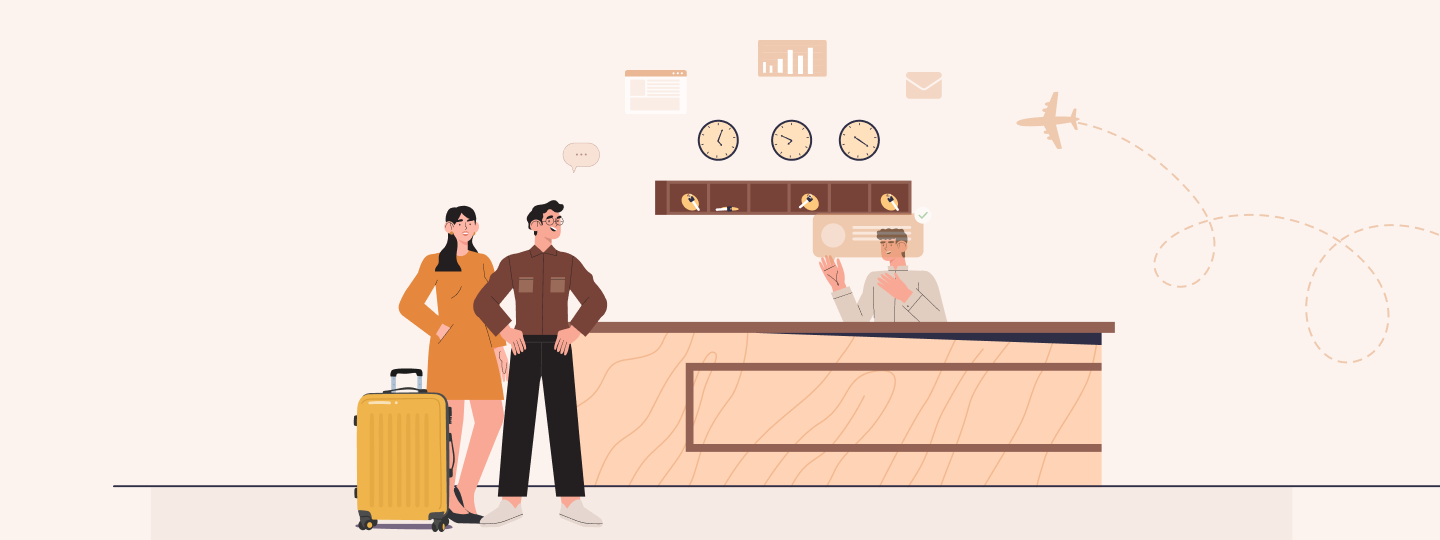Great brands stand out from the noise by implementing a well-crafted user engagement strategy, such as personalization, segmentation, and omnichannel engagement, that builds a lasting connection with their consumers. Brands that invest in improving their user engagement saw a 67% increase in revenue.
We had over 120 professionals in product management, marketing, and growth roles who belong to small, medium and big companies in industries including E-commerce, D2C, retail (offline), media and entertainment, EdTech, BFSI, healthcare, hospitality, and FMCG share their insight on how they engage users.
Some of the respondents are C-suite associates and executives, managers, founders, and department heads in Indonesia, providing insights into how different brands maximized their user engagement strategies.
A study found that 80% of users were more likely to buy something when offered personalized experiences, yet our survey concluded that only 11.2% of the respondents in Indonesia have used advanced personalization.
In this report, we will examine challenges, segmentation, personalization, AI adoption, and tools to enhance user engagement strategies.
Key Challenges
Before diving into the state, let’s take a close look at the common challenges that businesses in Indonesia often face in executing their user engagement strategy.
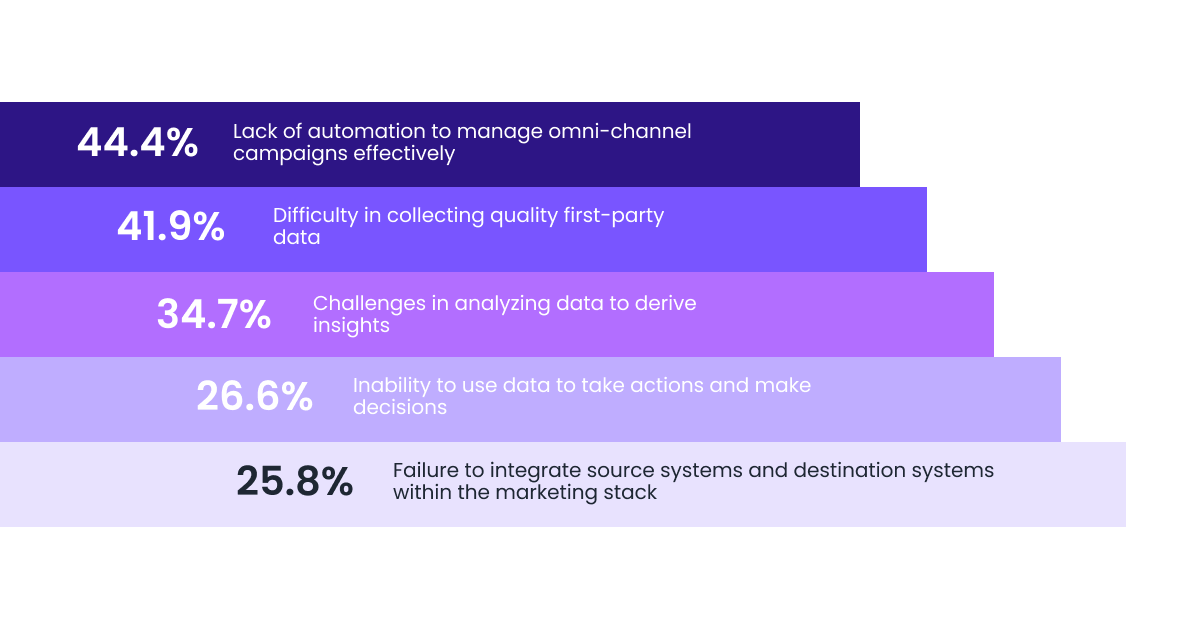
- Lack of automation to manage omnichannel campaigns effectively
In notable industries like FMCG, EdTech, E-commerce, and D2C, companies struggle to automate their marketing campaigns across multiple channels (e.g., email, social media, SMS), this can lead to manual errors, inefficiencies, and an unenjoyable user experience. Although retail (offline) and travel and hospitality organizations are less affected by this challenge according to the survey.
This affects both large and small companies as large companies have a lot of complexities and multiple channels for various customer segments, and small companies might have limited resources available.
- Difficulty in collecting quality first-party data
The success of a company’s user engagement strategy starts from collecting accurate first-party data.
Industries such as BFSI, E-commerce, and D2C grapple with the collection of high-quality first-party data, understandably because these sectors operate under stringent regulations, leading to enhanced protection of consumers’ data which can also make it challenging to create personalized and effective user engagement strategies. Industries in the healthcare, FMCG, and travel and hospitality sectors however have a lesser percentage of facing these challenges.
- Challenges in analyzing data to derive insights
Identifying relevant data, analyzing this data, and communicating insights to non-technical stakeholders for insights into what works for the users can also be a challenge for a strong user engagement strategy.
In our survey, 22% of small-sized companies face this challenge, and it can be due to relying on more manual data collection methods, which can be difficult to analyze. The higher percentage of industries facing this is in EdTech, travel and hospitality, and media and entertainment while healthcare and FMCG face a lesser percentage.
- Inability to use data to take actions and make decisions
Although some companies even collect and analyze data, they often fail to use it to inform their decisions and take action.
According to our survey, almost half of the respondents from the healthcare industry find it hard to utilize their data for decision-making. This is common with healthcare due to unique complexities tied to ethical and regulatory considerations, leading to more deliberative decision-making processes. While EdTech, media and entertainment, and other industries have fewer respondents who face this challenge.
- Failure to integrate source systems and destination systems within the marketing stack
Growth, marketing, and product teams of companies often have multiple marketing tools and systems such as CRM, marketing automation, and analytics, that may not integrate seamlessly. This lack of integration can lead to data silos and a fragmented user engagement strategy.
From our survey, FMCG, Healthcare, and Travel and Hospitality industries face more of this challenge, most likely due to the various teams managing users of the product. E-commerce, D2C, and BFSI industries hardly face this because they depend mostly on integrations when using their marketing stack.
Emerging Trends
As user engagement becomes a growing priority for companies, Indonesian businesses are currently focusing on the following trends:
1. Choosing the right channels
Choosing the right marketing channel means finding the best paths to connect with the customer. Knowing the channels your users prefer to be reached on will inform your engagement strategy.
There are two cuts of channels – the most used and the top performing:
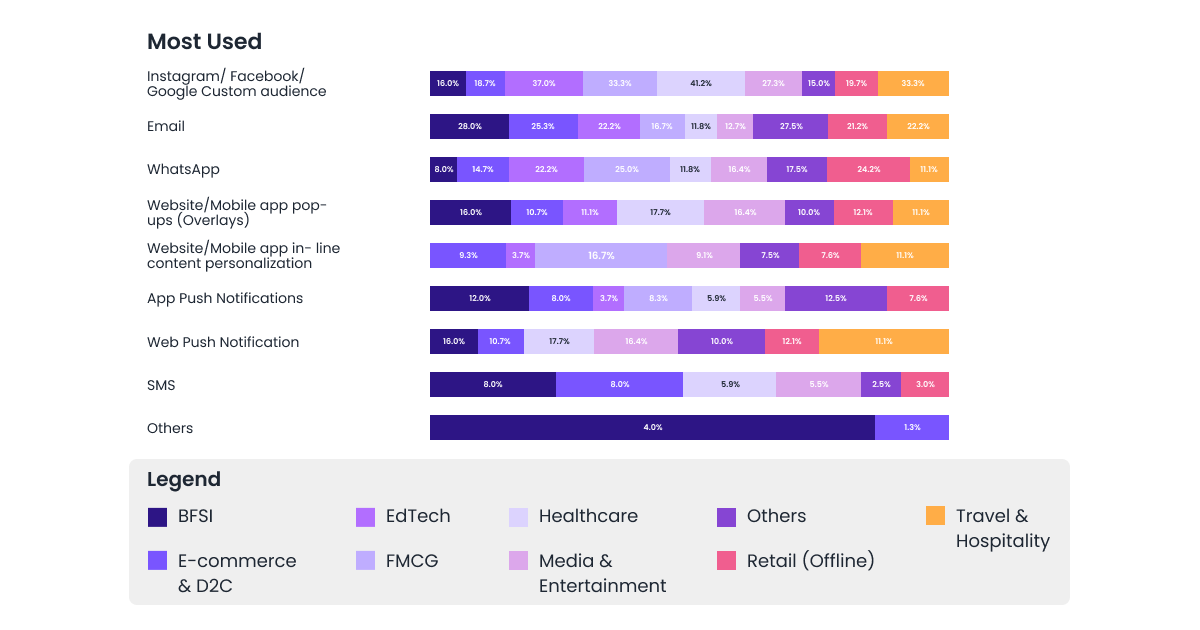
Instagram, Facebook, and Google Custom Audience are the most-used channels across all company sizes and industries like healthcare, FMCG, EdTech, and travel and hospitality followed by Email and WhatsApp, also used by the above industries in addition to BFSI and retail (offline) according to the survey.
While in the top performing channels, Instagram, Facebook, and Google Ads emerge in the FMCG, EdTech, and Healthcare industries, while Web Push Notifications and SMS are the least effective channels in industries like E-commerce, D2C, retail (offline), and others with their performance ratings significantly lower than their usage rates among respondents.
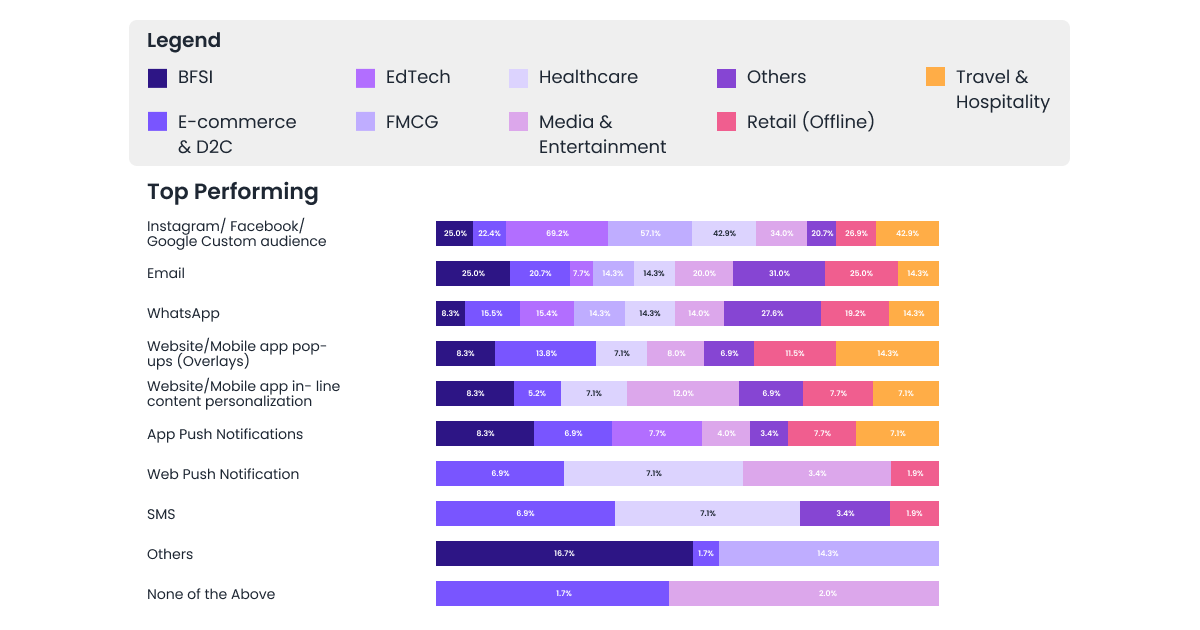
2. User Segmentation
Another emerging trend is segmenting users under basic and advanced values like city, interest, recency of purchase, frequency of purchase, predictive segmentation, and many more. By segmenting users, they can enjoy personalized experiences with relevant content, offers, and communications that resonate with them.
According to our survey, the majority of companies, particularly those in EdTech, Travel and Hospitality, and Retail, prioritize user segmentation to deliver personalized experiences. The end goal is to provide customers with tailored information and content that aligns with their interactions and behaviors with the product. The retail (offline) industry and some others have a high percentage of not using both basic and advanced segmentation.

3. Personalization
Personalization has become a cornerstone for effective marketing as it allows businesses to tailor their interactions with customers. Since there are different levels of personalization, none, basic and advanced, depending on industry and company size, personalization maturity varies.
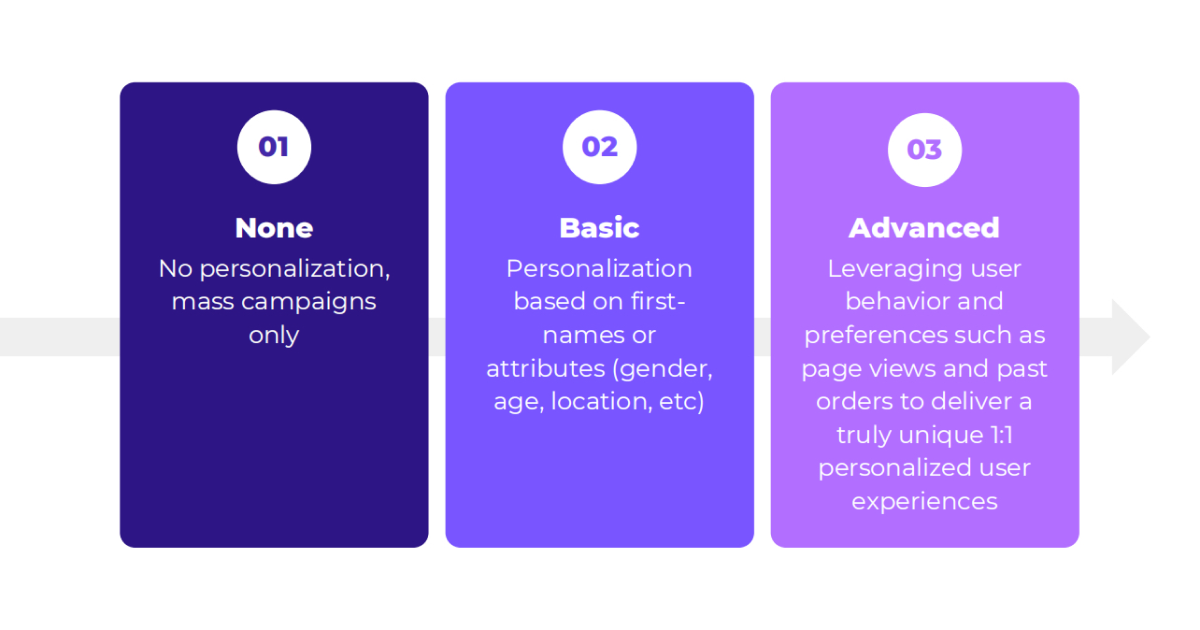
Getting to the stage of 1:1 personalization requires collecting and analyzing customer data, segmenting your audience, using a digital experience platform, personalizing across channels, and continuously optimizing. Because of the resources it requires, only 18.5% of companies can adopt it.
User behavior and preferences, user attributes, first-name personalization, only mass campaigns and advanced personalization choices by industries like travel and hospitality, healthcare, and BFSI are on a higher percentage while FMCG, retail and others have a lesser percentage of personalization across the survey.
User Engagement Stack
Without a user engagement stack, executing data-driven user engagement strategies would be difficult. According to our survey, Customer Data Platforms (CDPs) have seen the highest adoption rate in Indonesia, with an impressive 53.2% of companies utilizing this technology.
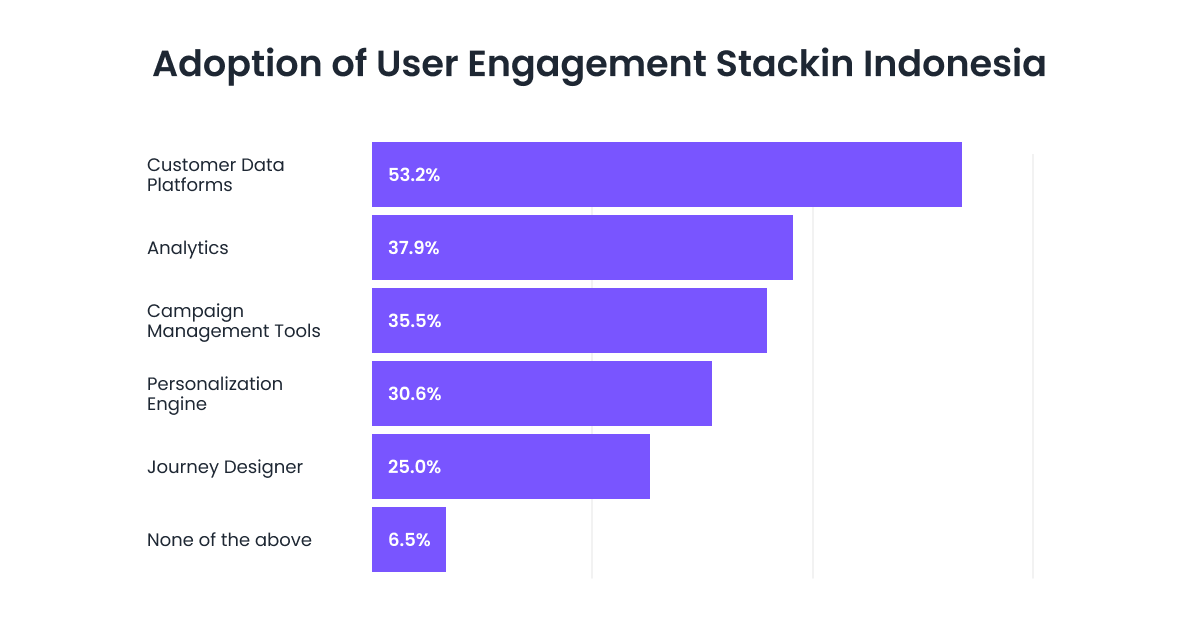
Here are the marketing tools commonly used by companies in Indonesia within their user engagement stack.
- Customer Data Platform (CDP): This is software that collects and unifies customer data from various sources, providing a comprehensive 360-degree view of each user. CDPs enable data integration, unification, and segmentation, allowing for a holistic view of customer information.
- Analytics: These tools are used to evaluate the effectiveness and success of companies’ marketing strategy, help them gather deeper consumer insights, optimize their marketing goals, get a better ROI, and make data-driven decisions.
- Campaign Management Tools: They are applications used to plan, execute, track, and analyze marketing campaigns from start to finish. They help monitor how well campaigns are doing for more effective marketing.
- Personalization Engine: As the name suggests, you can analyze user data to improve user experience with a personalization engine. Creating tailored content and recommendations for users is a big deal in user engagement strategy.
- Journey Designer: Drag-and-drop storyboarding interface to program user journeys as well as campaigns across multiple channels and touchpoints. With this, you can create visual representations of the marketing strategies and find loopholes to fill.
There remains substantial untapped potential for companies to explore and embrace additional tools, as the majority of these tools are currently utilized by less than 50% of the respondents. The adoption rates of industries including healthcare, FMCG, media and entertainment, and travel and hospitality are higher compared to BFSI, EdTech and others.
Also when comparing company sizes, it becomes evident that larger companies exhibit a greater preference for analytics tools (26.5%). Conversely, small and mid-sized companies display a shared inclination towards employing CDPs, with both groups at 30.1%.
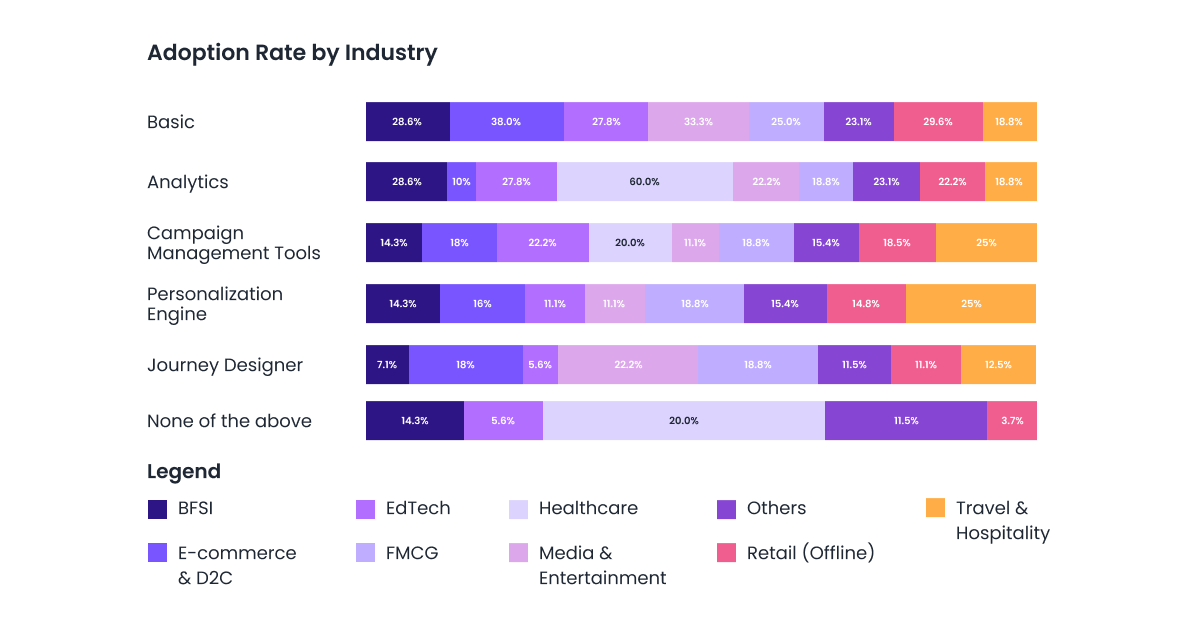
Artificial Intelligence (AI) In Marketing Stack
As user engagement grows globally, there’s also the advent of using AI in a marketing stack. Artificial Intelligence is making a big impact on various forms of media and is changing the way companies market their products and services.
In this survey, we found the rate of AI adoption in Indonesia based on different functions like:
- Channel Selection
- Product Recommendations
- Send-Time Optimization
- Communication Copy
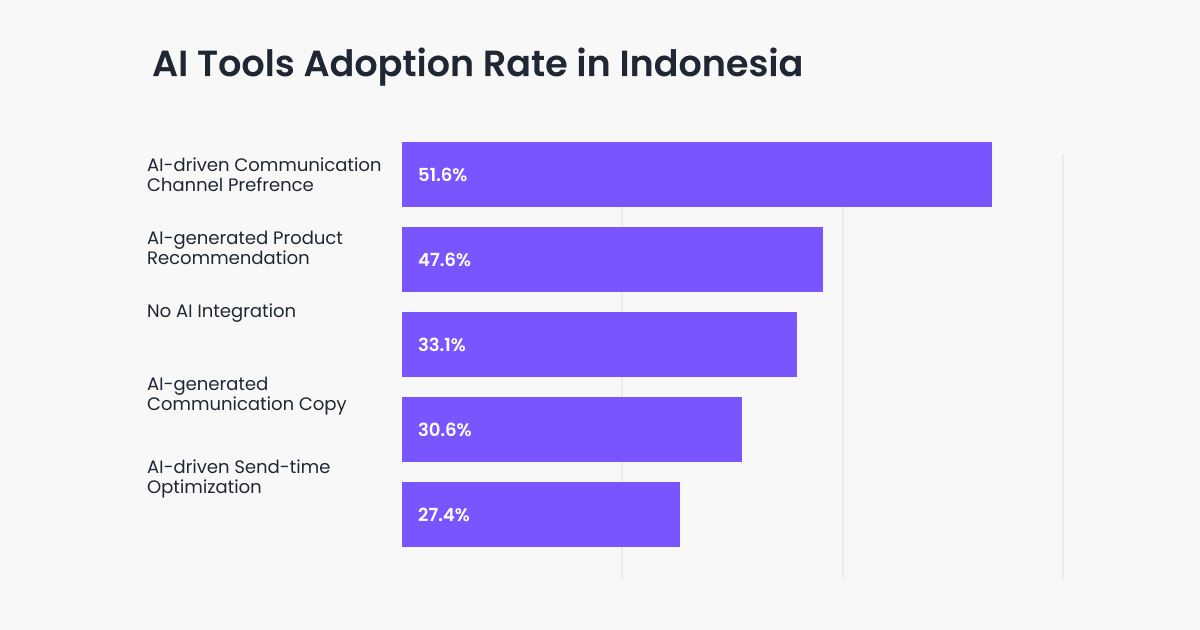
Much like user engagement tools, AI has the potential to accelerate a company’s growth and significantly enhance its user engagement strategy, yet our survey finds that 33.1% of respondents have not integrated AI in their current business. Starting with small steps, such as employing AI to generate content within your business, can contribute to efficiency improvements and scalability.
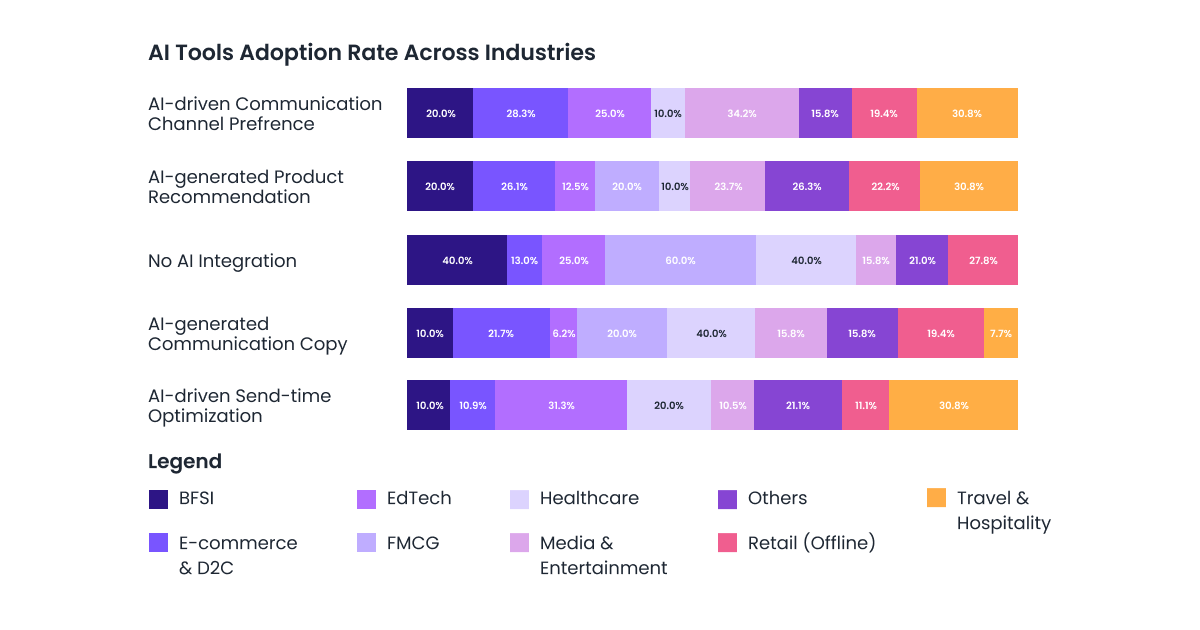
Companies are quick to embrace new technological advancements, with 66.9% of respondents reporting some AI integration. Interestingly, respondents from the Healthcare, BSFI, and FMCG appear to exhibit the lowest levels of AI integration.
In our report on ‘The State of User Engagement in Indonesia’, we found valuable insights from the survey that offers a glimpse into how various companies across the industries see and adopt user engagement.
Beyond this article, there’s a detailed report of this survey helping with how you can elevate your user engagement strategy, download your copy here.
Conclusion
This report was designed to paint a picture of user engagement strategies and tool adoption across various industries, channels, and company sizes in Indonesia. The survey indicates that the market is undergoing significant growth, and companies that seek to thrive must adopt measures and features to keep customers engaged and retained.
If you’re on the hunt for the perfect tool to add to your user engagement stack, you’re at the right place. We have spent the last 12 years helping 800+ brands at WebEngage. Book a demo, and let’s show you how it’s done.








 Vanhishikha Bhargava
Vanhishikha Bhargava

 Dev Iyer
Dev Iyer
